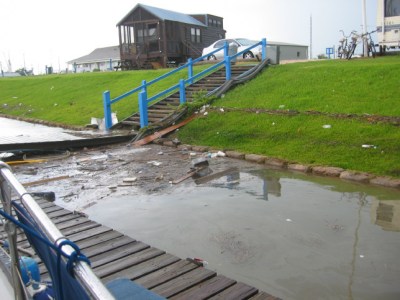Summer 2003
When we came to the south Texas coast for hurricane season, we didn’t mean we wanted a hurricane. But that is what we got when Hurricane Claudette rolled over the little town of Palacios and our dock at Serendipity Marina.
Claudette started as a tropical storm, passing over the Yucatan Peninsula with minimal winds but lots of rain. As it entered the Gulf of Mexico, it just couldn’t seem to get its act together. For days it slowly moved across the Gulf towards Texas and upper Mexico. The warm waters of the Gulf wanted to strengthen it, but upper level winds wanted to blow the top off the storm and weaken it. Eventually, the warm water won and it became a Category 1 hurricane just as it reached the coast.
We had watched the weather channel as it slowly wobbled our way, and began making preparations. We were on the north side - the dangerous semi-circle. We took the roller-furling jib down, removed the awning, tied the mainsail down securely, and put extra dock lines on Tigger. Because we expected minimal winds (40-50 knots) we decided to stay with the boat and make sure the dock lines held. But as the storm reached the coast, it intensified dramatically.
It crossed land during that day, and I sat in the cockpit and watched the wind speed indicator climb, first to 40 knots of north wind and then up. As it climbed through the 50-knot range, debris began to fly through the air - leaves first, then branches, then roof shingles, then parts of metal roofs. Fortunately, it all landed in the water around us and not on the boat. As the wind climbed through the 60-knot range the waters began to recede quickly, pushed out of the bay by the heavy winds.
The wind stayed steady in the 70-knot range as we crawled along the dock to secure even more lines to Tigger. We wrapped extra lines around the dock supports in case the dock cleats gave way. They were wobbling as the big gusts blew through.
The highest gust was 80 knots and after that the wind started dying. Maybe the worst was over. Maybe. The winds rose again and shifted to the east as the eye moved past us. But they were in the 50-knot range and after the higher winds they seemed gentle. Soon the storm surge began rolling in. The marina is protected by two breakwaters - and those helped control any wave action. The tide just rolled in and continued to rise until it was about 8 feet above normal high tide. However, the marina has floating docks that can take a 12-foot tidal surge, so we just rose with the tide.
Several hours later the winds had died to a brisk breeze and the storm was over - but not the damage to the boats and to the little town. Jibs were shredded and flapping in the breeze, awnings and dodgers were ripped away, and the large windows of several powerboats were smashed by flying debris. Land structures suffered the most damage with sheds demolished, roofs damaged or missing and mobile homes overturned and twisted. Trees were uprooted and torn all over town, and power was out and would remain out for six days. But damage to the boats was minimal. Floating docks and a double breakwater and a good location saved the marina from extensive damage.
Tigger was fine except for the Windex at the top of the mast. It blew away in the high winds. Had we known beforehand how intense the storm was going to be, perhaps we would have left the boat and gone inland. But I am glad we stayed, it’s good to be reminded now and then of the impersonal power of nature.
August
2002
September 2002
October 2002
November/December 2002
January 2003
February 2003
March 2003
April 2003
Summer 2003
Winter 2003-2004
|
||||||||||||||||||

Blown out roller furling jibs!

Debris line after the tidal surge